Those who cannot remember the past are condemned to repeat it.
George Santayana, Reason in Common Sense (1905)
History is more or less bunk.
Henry Ford, Chicago Tribune, 25 May 1916
I am an inveterate note taker. My earliest efforts were probably the scribbled observations collected for my Boy Scout “Nature” merit badge which required me to watch and document the insect activity at a patch of flowers in my front yard for a day. Unfortunately for the history of science, those notes are no longer extant.

As for the most recent 30 to 40 years of my outdoor career, we’re in pretty good shape.
Over the past several weeks--in my absence from this blog space--I have spent some time going back through notes covering four decades of my birdwatching observations*. More properly, I should say I’m “coming forward” through these notes, having started by digging out the first scraps of paper from 1970 and perusing subsequent notebooks, journals, and field checklists chronologically. Quite naturally, this has been a fun trip down memory lane. In the past few days, I’ve finally arrived at the period 1988-89 which has some relevance to this Refuge.
In an entry dated May 1, 1988, entitled “Wandering around”, I described how I went out to check on the spring migration only to find that there were no migrant birds evident in the woods along Walnut Creek on
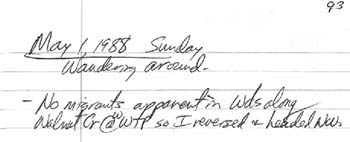
the east side of Austin so “I reversed [my course] and headed NW”. It was a fateful choice. For the previous few years, I had been intently studying the distribution of the Black-capped Vireo throughout it’s range. The species had only been listed as endangered by the U.S. Fish & Wildlife Service the previous October. I had begun to develop some ideas about where vireos might be found and why (think: geology). My new NW course out of Austin took me along RM 1431 west of Cedar Park and north onto Nameless Road. This pathway was inspired by some old sightings of Black-capped Vireos near the intersection of 1431 and Nameless Road by Charles Easley of Travis Audubon Society and by my perusal of some area geologic maps.
By the time I’d made it up to the Travis/Williamson County border on Round Mountain Road I had seen no patches of really good-looking vireo habitat but had encountered a small list of songbirds, one Sharp-shinned Hawk, and a cooperative Western Hognose Snake. I came over the gradual divide marking the county boundary and onto
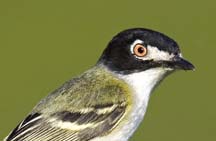
Williamson Co. Road 282. I screeched to a halt just a few hundred yards into Williamson County when I saw some oak brush intermingled with junipers. I jumped out of the car and listened for a moment...and up piped one singing male Black-capped Vireo! About a half mile up the road, another stop near some scrubby oak brush at the intersection of CR 282 and 281 yielded another singing Black-capped. The significance of these sightings was two-fold:
(1) These constituted the first records of Black-capped Vireo in (relatively underbirded) Williamson County, and (2) the locations of the brushy habitats which the vireos had chosen corresponded precisely with my theories of which geologic substrates best support vireo habitat.
I grabbed a quick celebratory snack in Liberty Hill, filled up with gas, and headed back out onto the narrow county roads west of town. My wandering eventually led me back onto RM 1869 and westward towards Burnet County. Just as I passed the Burnet County line, a large patch of shin oak brush presented itself on the south side of the road. Once again screeching to a halt--there was a lot of that going on that day--I stepped out of the car and was greeted by *multiple* singing Black-capped Vireos! A mile up the road on the same ranch, more shinnery blanketed the landscape. I’d hit the motherlode.
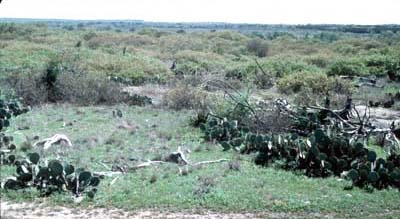 Low oak shinnery habitat on the Eckhardt ranch,
Low oak shinnery habitat on the Eckhardt ranch,
not much different from the way it looked in 1988 when Black-capped Vireos were discovered here.
The small clearing just beyond the grass and fallen trees marks the site of the (future) Shin Oak Observation Deck. At the time, there were just a few isolated records of Black-capped Vireos in the far west edge of Burnet County on the bluffs of Lake Buchanan, but nothing like this. I reported my findings later to the newly-formed Biological Advisory Team for the Austin Regional Habitat Conservation Plan, and the rest...as they say...is history. We determined that the large patch of oak shinnery was on a ranch owned by Donald Eckhardt. The Eckhardt ranch became one of the early additions to the newly-established Balcones Canyonlands NWR in 1992. That very same patch of shinnery now harbors the Shin Oak Observation Deck where no small number of visiting birders have tallied their “Lifer” Black-capped Vireo, and around which we continue to manage habitat for the Black-capped Vireo.
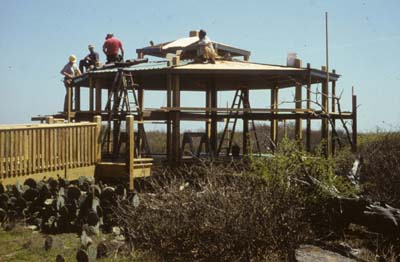 The Shin Oak Observation Deck, under construction in early 1998.
The Shin Oak Observation Deck, under construction in early 1998.
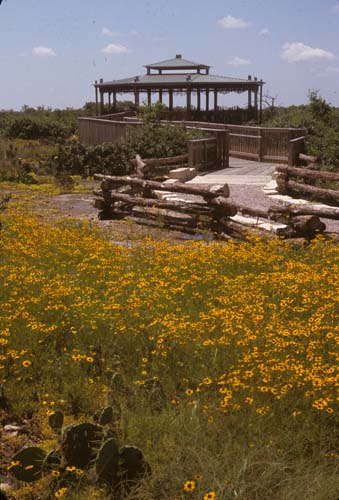
The history lesson? Keep on wandering and take good notes!
* * * * *
Below The Line:
Here are some even earlier versions of the wisdom on learning from the past:
Whoso neglects learning in his youth, loses the past and is dead for the future.
Euripides (ca. 485-406 BCE)
What experience and history teach is this--that people and governments never have learned anything from history, or acted on principles deduced from it.
G. W. F. Hegel, Philosophy of History, Introduction (1820).
* My review of birding journals has all been part of a somewhat obsessive and vain effort to see where I stand in the “Texas Century Club”, an inspired project sponsored by the Texas Ornithological Society to challenge birders to tally at least 100 bird species in as many counties as possible. [My thanks to fellow writer Bill Reiner Jr. for helping me put that last sentence into readable English. Any errors are, of course, my own.] So far, having reviewed just the first 20 years of my birding career, I’ve found at least 22 counties where I meet the century standard, and I’m still gleaning.
